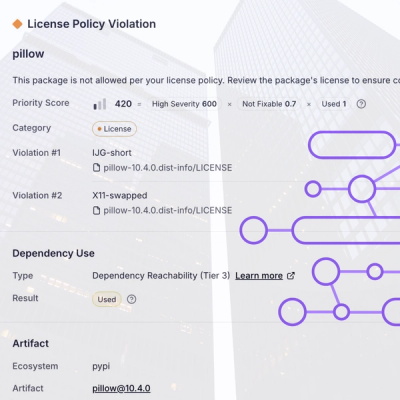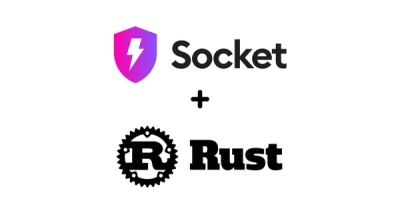
Research
/Security News
Critical Vulnerability in NestJS Devtools: Localhost RCE via Sandbox Escape
A flawed sandbox in @nestjs/devtools-integration lets attackers run code on your machine via CSRF, leading to full Remote Code Execution (RCE).
aggregate-array-extensions
Advanced tools
Simple extensions to the Array prototype for aggregating elements
Array.prototype.groupBy = function(keySelector, elementSelector, aggregateTransform)
| Parameter | Description |
|---|---|
| keySelector | Function that returns a value to group on |
| elementSelector | Function that is applied to each element of each group |
| aggregateTransform | Function that is applied to each group at the end of processing |
expect([1, 2, 3, 4, 5]
.groupBy(x => x % 2 === 0 ? 'even' : 'odd'))
.toEqual([
{ key: 'odd', value: [1, 3, 5] },
{ key: 'even', value: [2, 4] }
])
Array.prototype.groupIntoObject = function(keySelector, elementSelector, aggregateTransform)
| Parameter | Description |
|---|---|
| keySelector | Function that returns a value to group on |
| elementSelector | Function that is applied to each element of each group |
| aggregateTransform | Function that is applied to each group at the end of processing |
expect([1, 2, 3, 4, 5]
.groupIntoObject(x => x % 2 === 0 ? 'even' : 'odd'))
.toEqual({
odd: [1, 3, 5],
even: [2, 4]
})
Array.prototype.nearestUpperBound = function(value, selector)
| Parameter | Description |
|---|---|
| value | Value to find nearest upper bound for |
| selector | Function to select the bounded value. The array must be sorted by this value. |
var source = [1, 2, 4, 8, 11, 32]
expect(source.nearestUpperBound(0)).toBe(-1)
expect(source.nearestUpperBound(3)).toBe(1)
expect(source.nearestUpperBound(9)).toBe(3)
expect(source.nearestUpperBound(100)).toBe(5)
Array.prototype.nearestLowerBound = function(value, selector)
| Parameter | Description |
|---|---|
| value | Value to find nearest lower bound for |
| selector | Function to select the bounded value. The array must be sorted by this value. |
var source = [1, 2, 4, 8, 11, 32]
expect(source.nearestLowerBound(0)).toBe(0)
expect(source.nearestLowerBound(3)).toBe(2)
expect(source.nearestLowerBound(9)).toBe(4)
expect(source.nearestLowerBound(100)).toBe(-1)
Array.prototype.findRange = function(lower, upper, selector)
| Parameter | Description |
|---|---|
| lower | The lower bound |
| upper | The upper bound |
| selector | Function to select the bounded value. The array must be sorted by this value. |
var source = [1, 2, 4, 8, 11, 32]
expect(source.findRange(1, 32)).toEqual(source)
expect(source.findRange(3, 20)).toEqual([4, 8, 11])
expect(source.findRange(7)).toEqual([8, 11, 32])
expect(source.findRange(null, 7)).toEqual([1, 2, 4])
Array.prototype.sum = function(selector)
| Parameter | Description |
|---|---|
| selector | Function to select the value to sum |
expect([1, 2, 3, 4].sum()).toBe(10)
Array.prototype.mapIntoObject = function(keySelector, valueSelector)
| Parameter | Description |
|---|---|
| keySelector | Function to select the key on the result object |
| valueSelector | Function to select the value to assign |
expect([
{ v: 1 },
{ v: 2 },
{ v: 3 }
].mapIntoObject(x => x.v, x => x.v * 2))
.toEqual({
1: 2,
2: 4,
3: 6
})
FAQs
Simple extensions to the Array prototype for aggregating elements
The npm package aggregate-array-extensions receives a total of 0 weekly downloads. As such, aggregate-array-extensions popularity was classified as not popular.
We found that aggregate-array-extensions demonstrated a not healthy version release cadence and project activity because the last version was released a year ago. It has 1 open source maintainer collaborating on the project.
Did you know?

Socket for GitHub automatically highlights issues in each pull request and monitors the health of all your open source dependencies. Discover the contents of your packages and block harmful activity before you install or update your dependencies.

Research
/Security News
A flawed sandbox in @nestjs/devtools-integration lets attackers run code on your machine via CSRF, leading to full Remote Code Execution (RCE).

Product
Customize license detection with Socket’s new license overlays: gain control, reduce noise, and handle edge cases with precision.

Product
Socket now supports Rust and Cargo, offering package search for all users and experimental SBOM generation for enterprise projects.